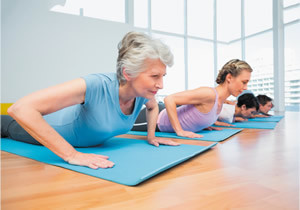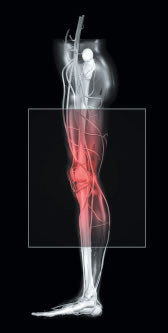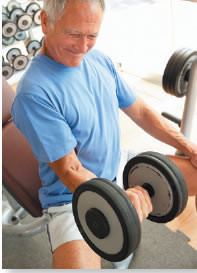
5 timeless habits for better health

What are the symptoms of prostate cancer?

Is your breakfast cereal healthy?

When pain signals an emergency: Symptoms you should never ignore

Does exercise give you energy?

Acupuncture for pain relief: How it works and what to expect

How to avoid jet lag: Tips for staying alert when you travel

Biofeedback therapy: How it works and how it can help relieve pain

Best vitamins and minerals for energy

Should you take probiotics with antibiotics?
Exercise & Fitness Archive
Articles
Core workout can cause muscle soreness
Many popular workouts that aim to strengthen your arms, legs, and abs give short shrift to many of the muscles that form your body's core (the group of muscles that form the sturdy central link connecting your upper and lower body). Strong core muscles are essential to improving performance in almost any sport — and are the secret to sidestepping debilitating back pain.
If you haven't been working your core muscles regularly — or if you challenge yourself with a new set of exercises — expect to feel a little soreness as you get used to your new routine.
Yoga's health advantages may extend to the heart
New research suggests yoga may be as good as moderate exercise for lowering heart disease risk. Images: Thinkstock |
With its focus on body, mind, and breath, yoga shows promise for improving heart health.
Feeling young at heart may help you live longer
People who feel young at heart are more likely to pursue physical activity, even it's an activity that's challenging. |
A youthful attitude may lead to better eating and exercising habits.
Could that leg pain be peripheral artery disease?
The pain of peripheral artery disease may be felt above or below the knee during activity, and will fade with rest. Image: Thinkstock |
The telltale sign is leg pain and fatigue that comes on with activity and goes away with rest.
Want to get healthier? Get your partner involved!
Plenty of research shows that we tend to exhibit the health behaviors of people around us, and that partners can influence each other's behavior. The influence carries even more weight if an unhealthy partner is making a change for the better. A study published in JAMA Internal Medicine Jan. 19, 2015, found that men and women were much more likely to make positive changes if their partners also changed their health behavior during the same period. The influence on a partner was significant: 67% of men took up physical activity if their wives did, but only 26% became active if their wives did not. The take-home message: get your partner on board if you both need to make healthy lifestyle changes.
Image: Thinkstock
Sitting may increase risk of early death
Even an hour's exercise a day won't protect you from an earlier death, if you spend most of the rest of your day sitting. That's the verdict of Canadian researchers who pored over data from 47 studies on the effects of sedentary behavior. When they combined the results of all the studies, the researchers found that regardless of their levels of physical activity otherwise, people who sat for long periods had an increased risk of developing a host of diseases. People who sat the longest had a 24% greater risk of dying, an 18% greater risk of heart disease, a 13% greater risk of cancer, and a 90% greater risk of diabetes. The results were published in the Jan. 20, 2015, issue of Annals of Internal Medicine.
| The researchers recommend standing for a minute or two every half‑hour when you have a task that keeps you chair‑bound. It may help to set a timer or alarm to sound at half-hour intervals. |
Neck pain: Core exercises can help
Neck aches are often the result of wear and tear, poor posture, and weak core muscles. Image: Thinkstock |
Better support for your spine is key in avoiding neck ache.
Safe exercise: Know the warning signs of pushing too hard
Your heart should beat Image: Thinkstock |
Chest pain, dizziness, and shortness of breath mean you should back off and call your doctor.
Add weight training to control belly fat, say Harvard researchers
Images: Thinkstock |
Aerobic exercise is not enough to fight belly fat, according to researchers at the Harvard School of Public Health. They say that weight training is also key to fighting the battle of the bulge. Researchers analyzed physical activity, weight, and waist circumference data for more than 10,000 men ages 40 and older, and found that healthy men who did 20 minutes of daily weight training had less of an increase in age-related abdominal fat compared with men who spent the same amount of time doing aerobic activities. Aerobic exercise alone was associated with less weight gain compared with weight training. The best results came from combining weight training and aerobic activity. The findings were published online Dec. 22, 2014, in Obesity. "Engaging in weight training or, ideally, combining it with aerobic exercise could help older adults lessen abdominal fat while increasing or preserving muscle mass," says Dr. Rania Mekary, the study's lead author and a researcher in Harvard's Department of Nutrition.
Abdominal fat is linked to heart disease, diabetes, bone loss, and decreased bone strength. You can fight back by aiming for the recommended 150 minutes of moderate-intensity exercise per week and starting a weight-training program if your doctor approves.
Balance and strength exercises may help reduce falls
It appears that exercise may significantly reduce falls among people with less severe PD, and may improve balance and quality of life for anyone with PD.

5 timeless habits for better health

What are the symptoms of prostate cancer?

Is your breakfast cereal healthy?

When pain signals an emergency: Symptoms you should never ignore

Does exercise give you energy?

Acupuncture for pain relief: How it works and what to expect

How to avoid jet lag: Tips for staying alert when you travel

Biofeedback therapy: How it works and how it can help relieve pain

Best vitamins and minerals for energy

Should you take probiotics with antibiotics?
Free Healthbeat Signup
Get the latest in health news delivered to your inbox!
Sign Up










